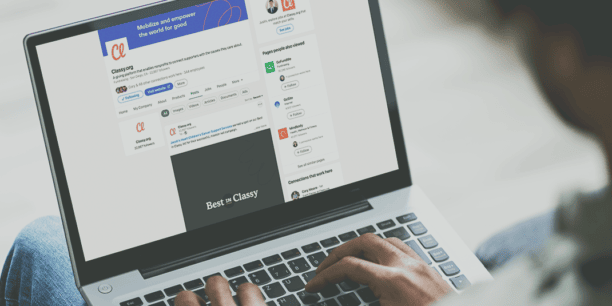How to Become a Nonprofit Thought Leader on LinkedIn

The digital age transformed the way we share ideas and promote our unique points of view. While many professionals think of LinkedIn as a space solely for networking, it’s also a fantastic platform for storytelling, authenticity, and impact.
By creating, sharing, and engaging with content that’s authentic to who you are, you’re indirectly communicating your values and the values of your nonprofit. Embracing your personal identity on LinkedIn helps establish a memorable brand and attract a like-minded following.
Learn how to elevate your trusted voice on LinkedIn as a thought leader in the nonprofit space and garner support for your organization with these five tips.
Your Complete LinkedIn Checklist
Why Is Thought Leadership So Important?
Thought leadership is the most influential channel in today’s economy.
On an individual level, your distinction as a trusted nonprofit expert captures the attention of wider audiences to organically expand your reach. On an organizational level, earning a reputation for being the go-to resource within the sector boosts supporters’ confidence in donating to your cause.
Establishing thought leadership begins with authenticity. Connect with like-minded people who are more likely to engage with your content. Allow those conversations to strengthen your reputation as a reliable source and capitalize on that personal exposure to seamlessly increase the visibility of your organization.
5 Ways to Advance Your Thought Leadership on LinkedIn
1. Establish a Consistent Posting Cadence
A large part of connecting with your audience in meaningful ways is posting quality content on a consistent basis. Demonstrate your expertise and keep your followers engaged to gain their long-term support.
Ensure you’re making a strong first impression with a professional LinkedIn profile. Here are a few must-have elements to consider:
- Select the right profile picture
- Customize your headline to illustrate your value
- Tell your unique story in your page summary
- Incorporate engaging visual elements, like a custom background image
- List relevant work experience
- Spotlight your achievements, awards, and certifications
Next, solidify your posting cadence by creating a pre-set plan of how often you’ll be sharing content with your network. Posting once a day is recommended, but starting with 3-5 times per week may be more realistic for your current schedule.
Remember to:
- Capitalize on the peak hours of Tuesday through Thursday, 8 a.m. to 3 p.m.
- Schedule posts for times when you’re able to comment and engage with your followers
- Consider the time zones of your audience
Lastly, consistency is only as valuable as the content you share. Posting on a regular cadence is critical to gaining followers. However, the quality of your content is what keeps those followers coming back.
If you can’t produce valuable content at a high volume, it’s best to reduce your output and focus on the impact of your message.
2. Showcase Your Personality
It’s important to remember that your network chose to follow you as an individual, not just your organization. Most people are more interested in connecting with others we can relate to on a human level than a buttoned-up brand or company.
Here a few simple tips to keep in mind:
- Use common language that is welcoming, approachable, and relaxed, like you’re speaking with a friend
- Share monumental moments that reflect your character, both personally and professionally
- Leave comments on content that you relate to and explain why it resonates, without slipping into too much professional jargon
- Publicly or privately connect with others to ask questions or discuss a shared experience
- Think about what type of content you’d like to see on LinkedIn and shape your interactions around that
- Avoid any topics that are too polarizing to avoid backlash, unless they are central to your nonprofit’s mission
3. Build Trust Through Authenticity
You and your nonprofit team are experts in your craft. Find opportunities to openly share your personal and professional learnings to inspire, educate, and inform your network.
Consider writing LinkedIn articles to elaborate on your nonprofit’s wins and losses. You could even go live on your feed to tell your story in real time and build deeper connections. Discuss a new project you or your team is working on, or a recent roadblock that interfered with your success.
When sharing these experiences, think about how your personal and professional values played a role. Connect your decision making back to your unique belief system to remind others what you stand for. It can also be helpful to clarify the intention behind each action when analyzing the outcomes of your personal projects, nonprofit campaigns, or other initiatives.
Above all else, don’t be afraid to admit your imperfections. While it may seem counterintuitive to share failures or mistakes, it actually serves as a positive reminder that we’re all still learning, growing, and evolving. Normalize those moments of frustration and use them as touchpoints for connection.
4. Share Content That Resonates
Striking the right balance of authentic personal content and valuable professional resources on LinkedIn will differ depending on your unique audience. Experimenting with various topics, content formats, and emerging trends can be helpful in better understanding what your network is most interested in.
Stay in line with LinkedIn best practices to optimize your posts and boost engagement, and explore LinkedIn’s advanced tools to elevate your strategy.
A few of LinkedIn’s top content tools include:
- Content Suggestions: Discover and share content that your member community is engaging with, like Trending Articles, Employee Milestones, and Company News
- LinkedIn Articles: Publish articles about your expertise and interests that will be displayed in the Activity section of your profile
- LinkedIn Newsletter: Write about a professional topic you’re interested in to engage with your network on a consistent basis and stay top of mind with your community
- Content Boosting: Extend your reach to a larger audience, beyond your followers
- Events and Groups: Build and engage an active community that shares your values, passions, and goals
For more ways to amplify your voice on LinkedIn, download our complete checklist.
5. Evaluate Your Metrics to Deliver the Most Value
Gain insight into who is engaging with your content, how often, and how other leaders in the space are supporting your message to ensure you’re giving your audience what they want and need.
On LinkedIn, you can easily access and review analytics for your posts, articles, and videos. From the Post Analytics page you can see:
- Engagements
- Discovery
- Impression demographics
- Article performance
- Article viewer demographics
- Video performance
- Video viewer demographics
Set time aside on a weekly, bi-weekly, or monthly basis to dive into your analytics and align your strategy with emerging trends. Keep tabs on how often your name or content is being mentioned by others by checking your Activity tab, and take note of whether or not your nonprofit’s website is generating more traffic as a result of your growing brand.
Drive Meaningful Impact on LinkedIn
In its simplest form, LinkedIn serves as a platform to convey your personality, showcase your professional expertise, and prove your unique value.
Prioritize authenticity in the content you create and share things that humanize you in a relatable, approachable way. When people resonate with your values and beliefs on a personal level, they are more likely to trust and support you and the work of your nonprofit.
For more tips on how to advance your personal and professional mission on LinkedIn, download our Complete LinkedIn Checklist.
Posted in Fundraising Marketing Social Media

LinkedIn for Nonprofits: The Complete Checklist
Subscribe to the Classy Blog
Get the latest fundraising tips, trends, and ideas in your inbox.
Thank you for subscribing
You signed up for emails from Classy
Request a demo
Learn how top nonprofits use Classy to power their fundraising.



